The Ryzen 7000X3D processors are the best gaming processors on the market. With the Ryzen 7 7800X3D starting at <$400, the V-Cache chips are faster, affordable, and more power-efficient than their Intel rivals. The 7800X3D has been AMD’s bestselling CPU for a year now, with the Ryzen 9 7950X3D also earning its place. The 7900X3D is the middle child, offering a bit of this and a bit of that but enough of neither.
| AMD Ryzen 9 7950X3D | AMD Ryzen 9 7950X | AMD Ryzen 7 7800X3D | Intel Core i9-13900K | |
|---|---|---|---|---|
| CCDs | 2 | 2 | 1 | 1 |
| Cores/Threads | 16/32 | 16/32 | 8/16 | 24/32 |
| Base Clock | 4.2GHz | 4.7GHz | 4.2GHz | 3.0GHz |
| Boost Clock | 5.7GHz | 5.7GHz | 5.0GHz | 5.8GHz |
| L3 Cache | 32MB+32MB+64MB | 32MB+32MB | 32MB+64MB | 36MB |
| Power | 120 watts | 170 watts | 120 watts | 253 watts |
| Socket | AM5 | AM5 | AM5 | LGA1700 |
| Price | $662 | $549 | $369 | $543 |
The Ryzen 7 7800X3D and Ryzen 9 7950X3D are similar except for one thing. In addition to the Zen 4 3D V-Cache die (rainbow marking) on the former, the latter features a second Zen 4 CCD (without the stacked cache). You’d think that’d make it the better CPU, but that’s not always the case.
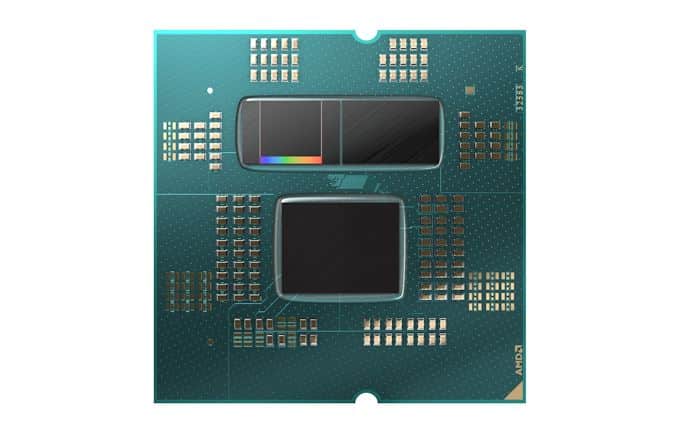
Test Bench
- Motherboard: ASUS X670E Maximus Hero.
- Cooler: Lian Li Galahad 360
- Memory: 16GB DDR5 x2 @ 6,000MT/s.
- Graphics Card: NVIDIA RTX 4090 FE.
- Power Supply: Corsair HX1000i.
Test Methodology
In gaming workloads, the CPU paints the outline of a scene, leaving instructions for the GPU about the various objects->meshes->polygons that need to be rendered. The GPU does the actual rendering, following the outline or blueprint left by the CPU. In general, the object detail is altered by increasing/decreasing the polygon or pixel count.
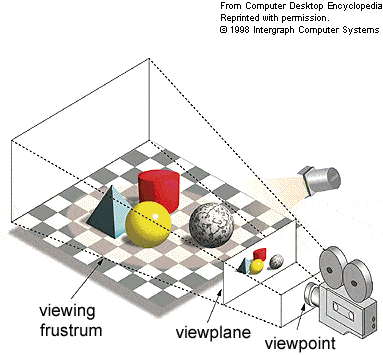
The polygons affect the actual appearance of the object, making it more or less detailed. The instructions for that are left by the CPU in the outline (known as draw calls). In-game, this is controlled by the terrain/mesh/geometry settings in the graphics menu.
The scene geometry has a direct impact on CPU performance. On the other hand, the resolution or pixel count is GPU-controlled as it affects how many samples are used to represent the 3D scene in rasterized form.
Therefore to gauge CPU performance, we limit the resolution to 720p (to remove GPU bottlenecks) and turn up the graphics settings to “Ultra.”
AMD Ryzen 7 7800X3D vs Ryzen 9 7950X3D: Gaming Benchmark
A Plague Tale: Requiem
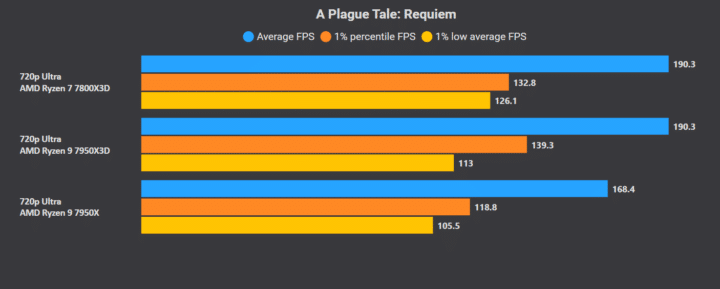
A Plague Tale performs similarly on the Ryzen 7 7800X3D and the Ryzen 9 7950X3D. The former delivers slightly higher lows, but the difference is too trivial to make a notable impact on the resultant performance. This one’s a tie.
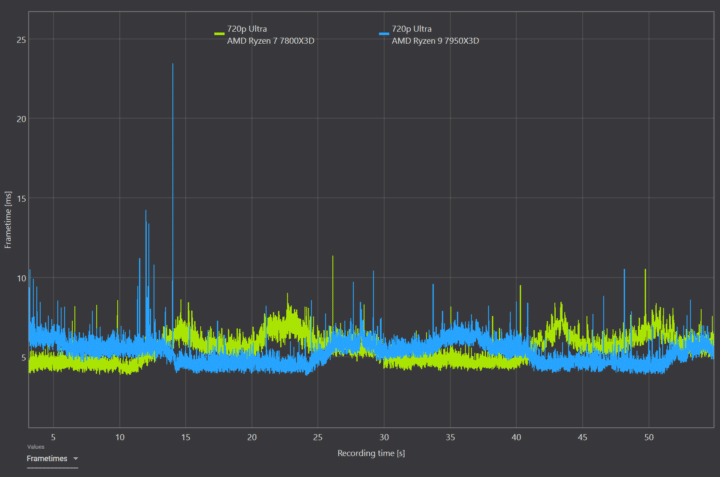
Assassins Creed: Valhalla
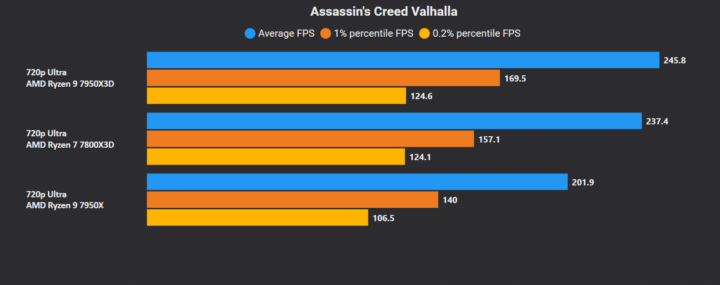
Assassins Creed: Valhalla sees the Ryzen 9 7950X3D edge past the Ryzen 7 7800X3D, maintaining a slim but consistent lead over its octa-core sibling. The frametime graphs look the same on the two sides.
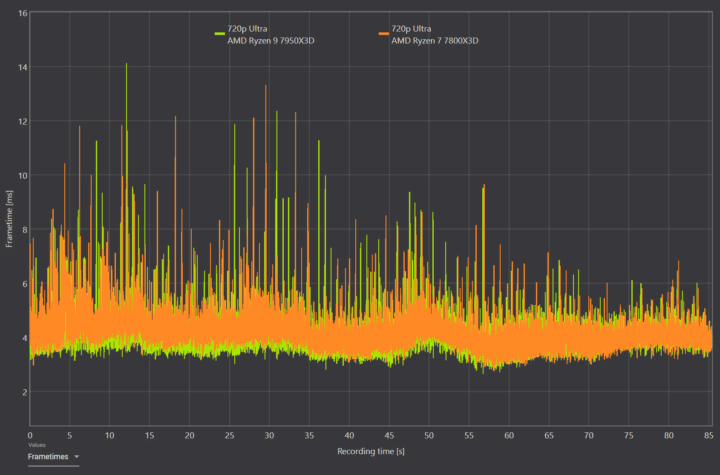
Cyberpunk 2077
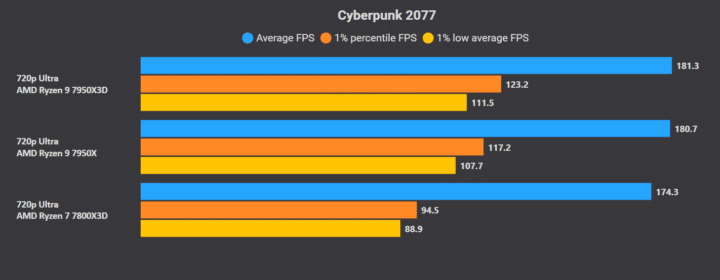
Cyberpunk 2077 is the ray-tracing heavyweight of our benchmark suite. At 720p Ultra (without ray tracing), the Ryzen 9 7950X3D is slightly faster than the 7800X3D. Barring a spiky patch near the end, the frame time graphs of the two CPUs are very similar.
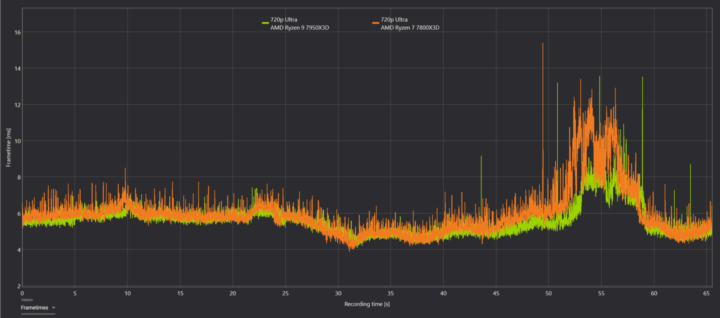
Dying Light 2
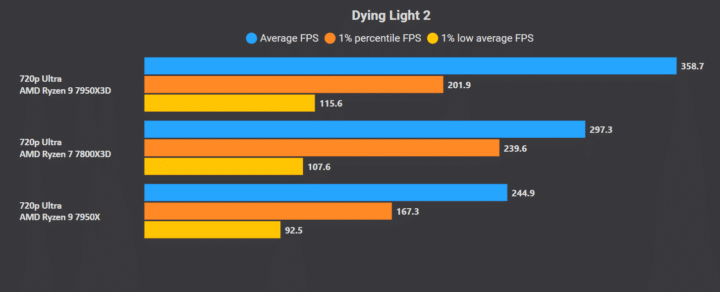
Dying Light 2 loves the extra L3 cache, granting the 7950X3D a lead of nearly 50% over the 7950X. In rasterization, it’s over 20% faster than the 7800X3D while producing worse lows. The Ryzen 7 7800X3D is the better performer overall.
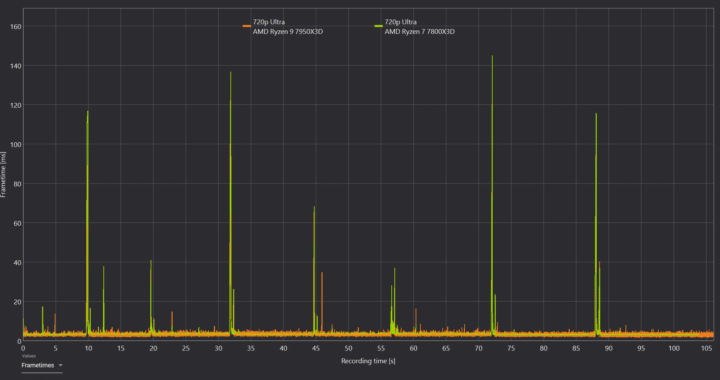
F1 2022
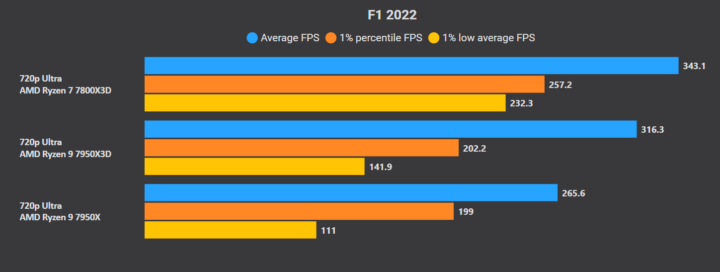
F1 2022 exhibits similar behavior, conferring the Ryzen 7 7800X3D with a lead of ~10% over the Ryzen 9 7950X3D. The frametime graph of the octa-core X3D chip is also cleaner than its 16-core sibling.
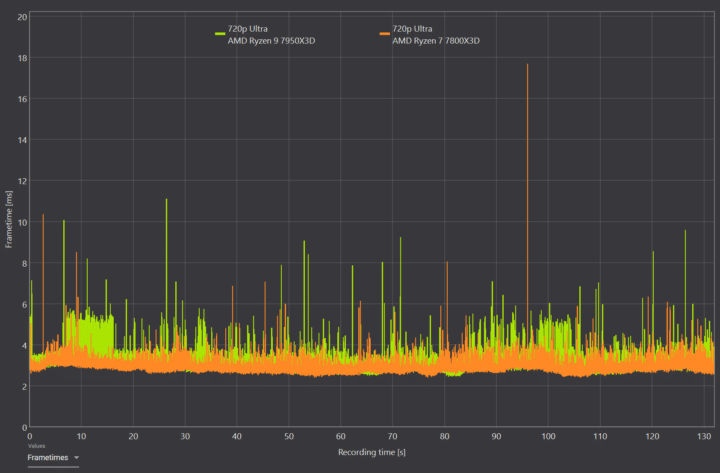
Ghostwire: Tokyo
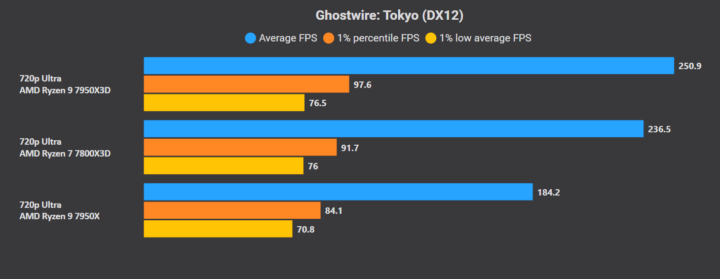
Ghostwire: Tokyo runs faster on the Ryzen 9 7950X3D, granting it a slim but distinguishable lead over the 7800X3D. The frametime graphs look similar, but the 7950X3D produces a relatively cleaner output.
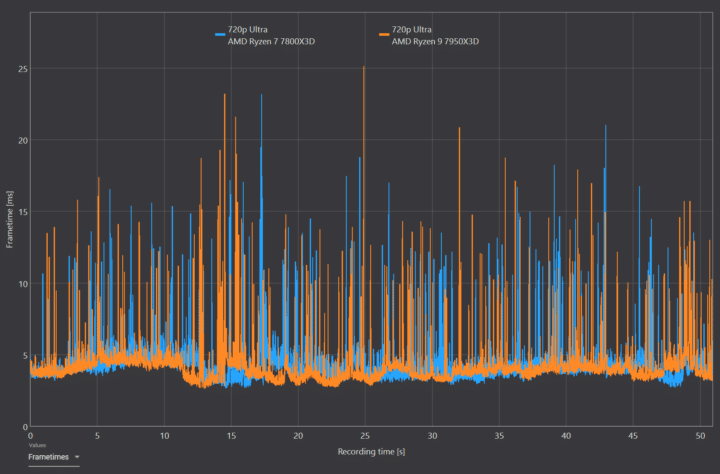
Hitman 3
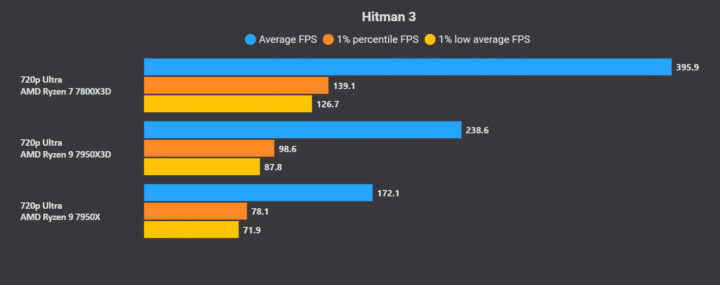
Hitman 3 and the Ryzen 7 7800X3D are the best of friends. The octa-core 7800X3D beats the 7950X3D by a massive 60-65% deficit in rasterization. The frametime graph of the former is also much cleaner, indicating a smoother experience.
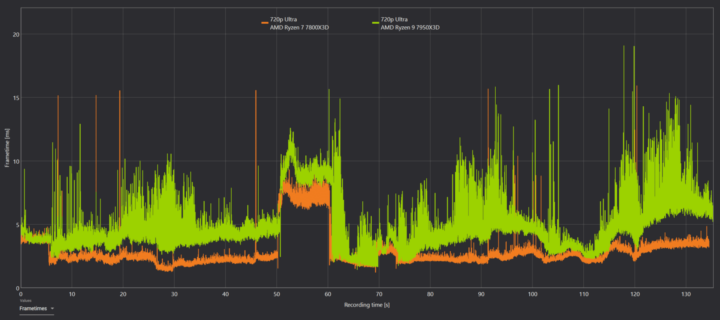
Shadow of the Tomb Raider
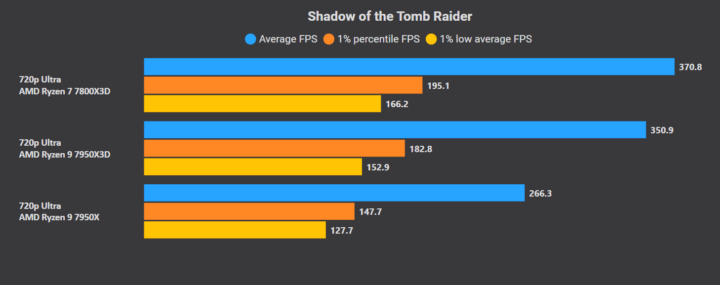
Shadow of the Tomb Raider performs more gracefully on the Ryzen 7 7800X3D. The frametimes, too are smoother on the octa-core X3D CPU compared to the 7950X3D.
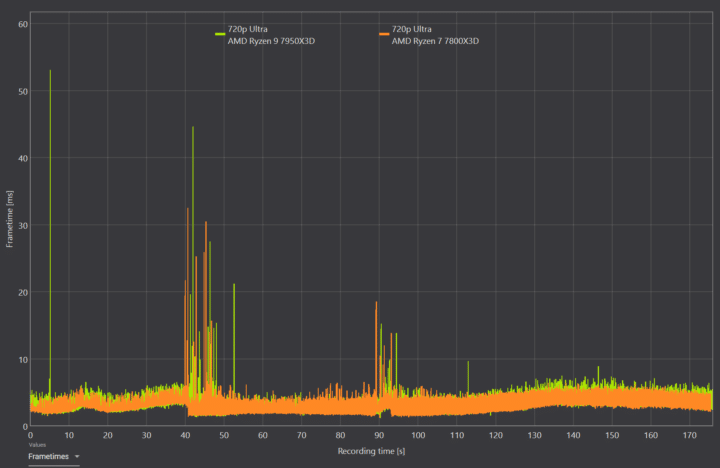
The Callisto Protocol
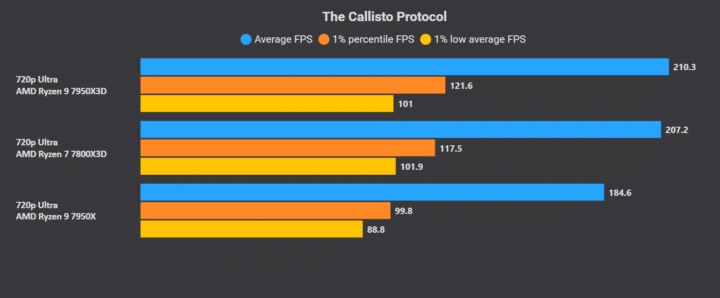
The Callisto Protocol is the exact opposite. The Ryzen 9 7950X3D is a smidge faster than the 7800X3D, with higher lows and a cleaner frametime graph.
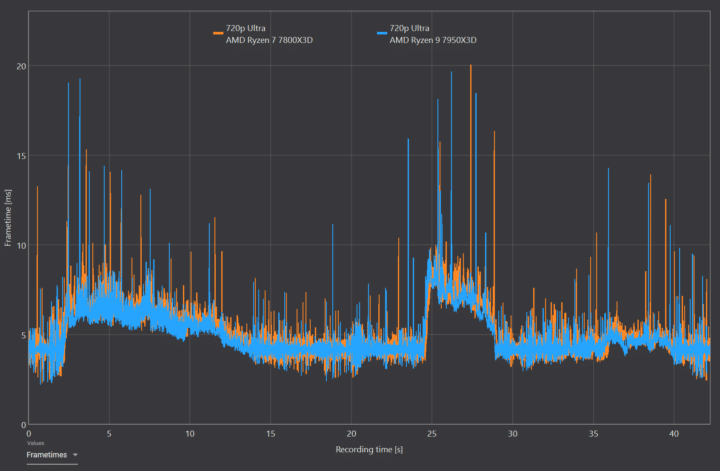
Tiny Tina’s Wonderlands
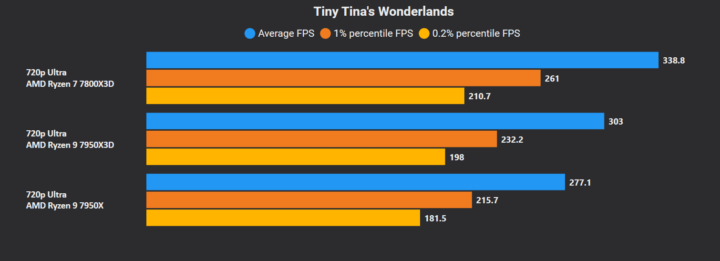
Tiny Tina’s Wonderlands prefers the Ryzen 7 7800X3D over the 7950X3D. The 7800X3D is ~12% faster than its Ryzen 9 sibling in this game.
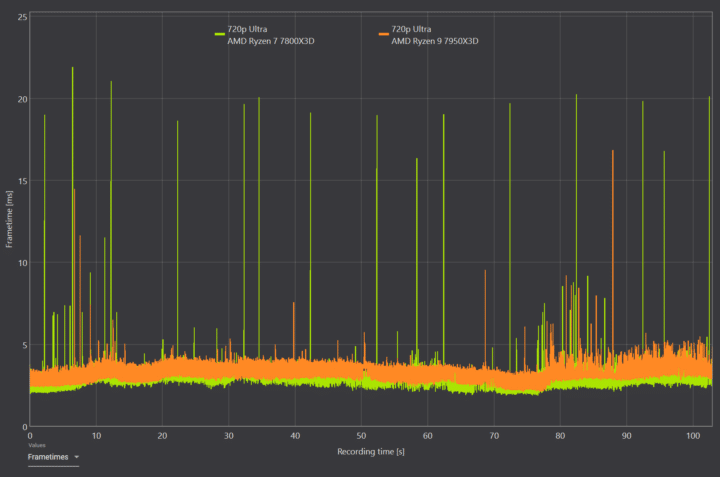
Average Gaming Performance
In standard rasterization-based gaming workloads, the Ryzen 7 7800X3D is slightly faster than the Ryzen 9 7950X3D. On average, the octa-core CPU holds a 2% lead over the 16-core X3D flagship through our 10-game benchmark suite.
| Game | Ryzen 7 7800X3D (Avg FPS) | Ryzen 9 7950X3D (Avg FPS) |
|---|---|---|
| A Plague Tale | 190.3 FPS | 190.3 FPS |
| Assassin’s Creed: Valhalla | 237.4 FPS | 245.8 FPS |
| Cyberpunk 2077 | 180.7 FPS | 181.3 FPS |
| Dying Light 2 | 297.3 FPS | 358.7 FPS |
| F1 2022 | 343.1 FPS | 316.3 FPS |
| Ghostwire: Tokyo | 236.5 FPS | 250.9 FPS |
| Hitman 3 | 395.9 FPS | 328.6 FPS |
| Shadow of the Tomb Raider | 370.8 FPS | 350.9 FPS |
| The Callisto Protocol | 207.2 FPS | 210.3 FPS |
| Tiny Tina’s Wonderlands | 338.8 FPS | 303 FPS |
| 10 Game Average | 279.72 FPS | 273.61 |
Ray tracing benchmarks on the next page…
AMD Ryzen 7 7800X3D vs Ryzen 9 7950X3D: Ray Tracing Performance
Enabling ray tracing increases the load on the CPU and the GPU. The CPU issues the draw calls to initiate the BVH construction and the ray generation, while the GPU does the BVH testing, ray-tri/box testing and the eventual shading. This whole process is becoming more GPU-localized with every new generation of RTX GPUs.
A Plague Tale: Requiem
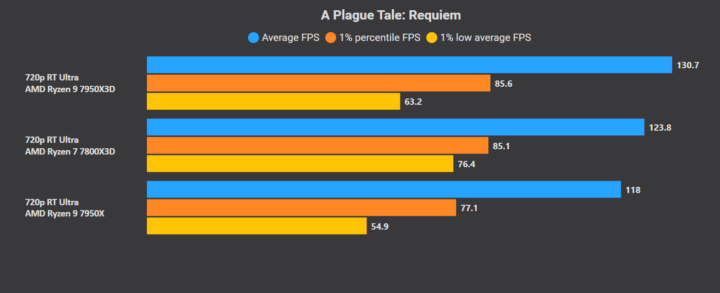
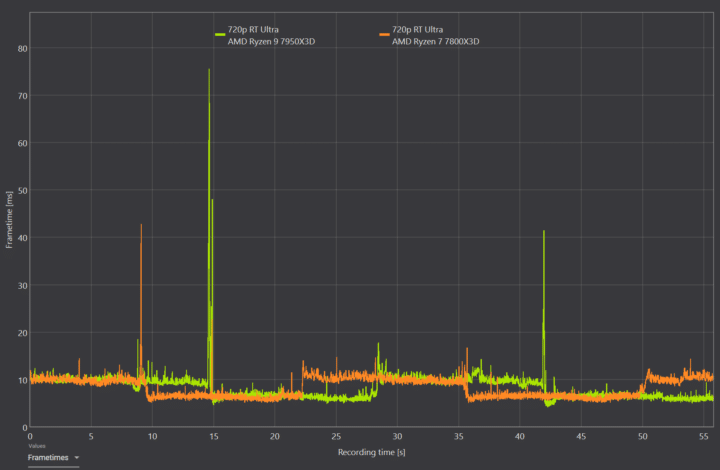
Crysis Remastered
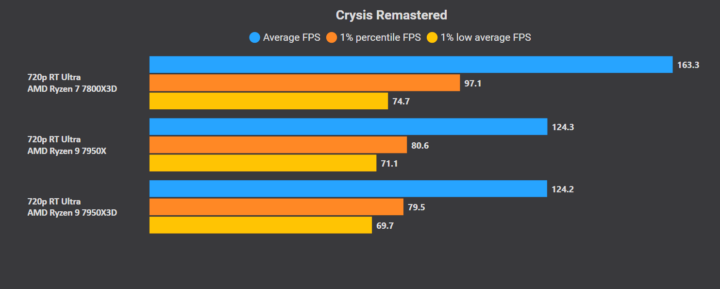
Crysis Remastered doesn’t like the 16-core Ryzen 9 parts as the 7800X3D takes a massive lead over its pricier siblings. Interestingly, the frametimes of the two chips were very similar, indicating a smooth experience.
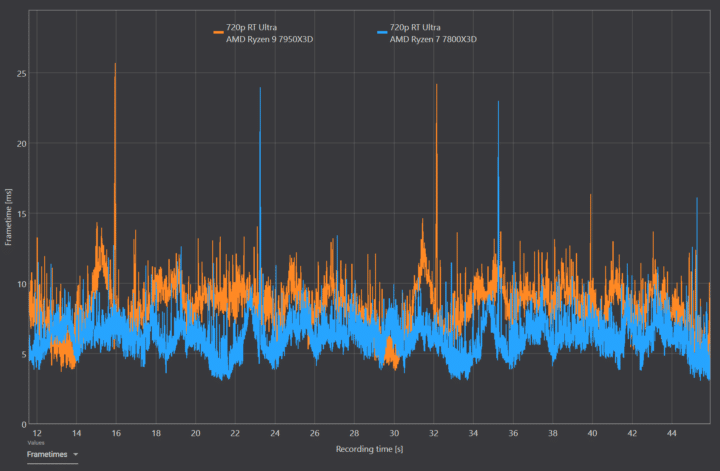
Cyberpunk 2077
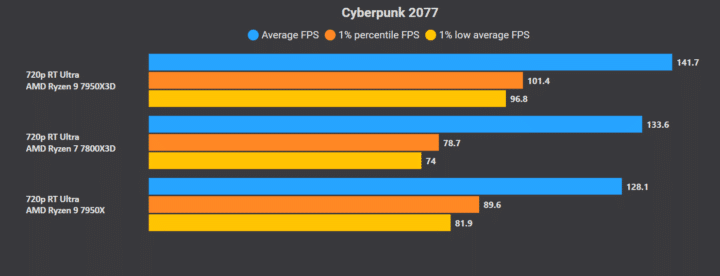
Cyberpunk 2077 runs even better on the Ryzen 9 7950X3D with ray-tracing, while the Ryzen 7 7800X3D suffers from relatively lower 1% percentile FPS. This is likely because this game can utilize up to 16 CPU cores or more. The frametimes look similar, except for that little stutter patch on the 7800X3D near the end of the test.
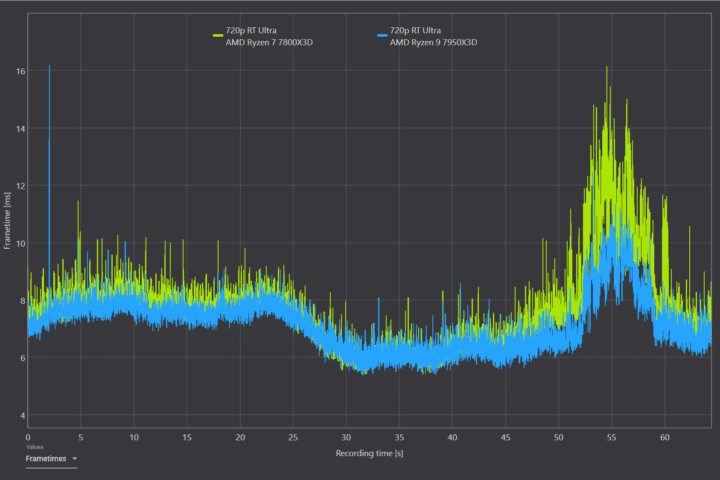
Dying Light 2
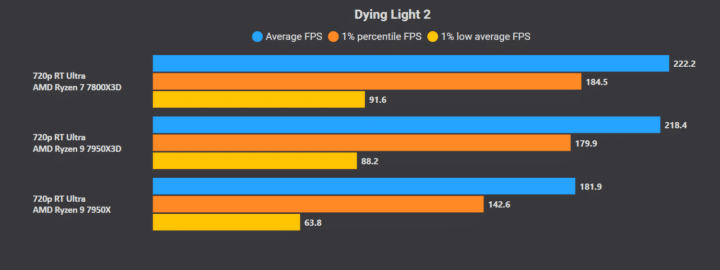
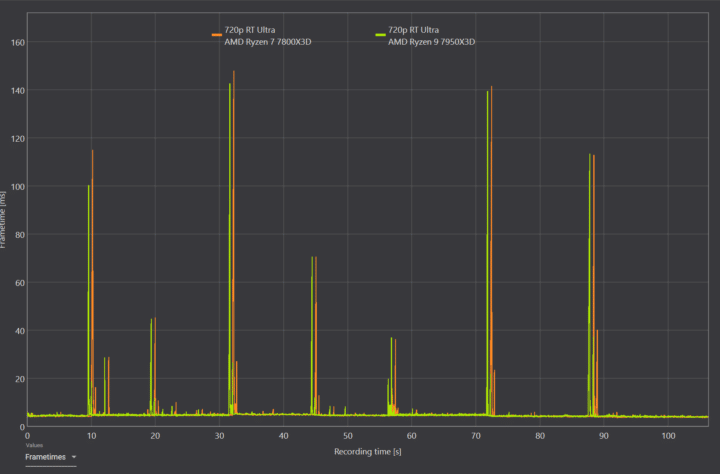
F1 2022
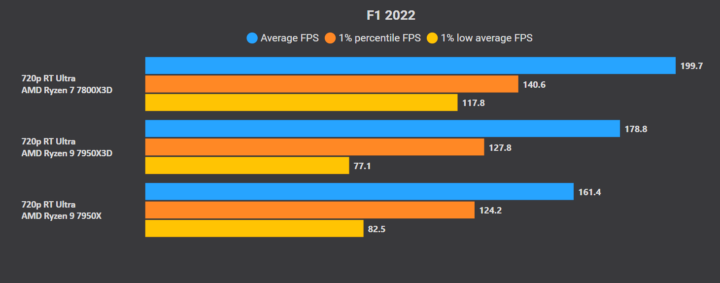
F1 2022 runs better on the Ryzen 7 7800X3D while delivering smoother frametimes than the Ryzen 9 7950X3D.
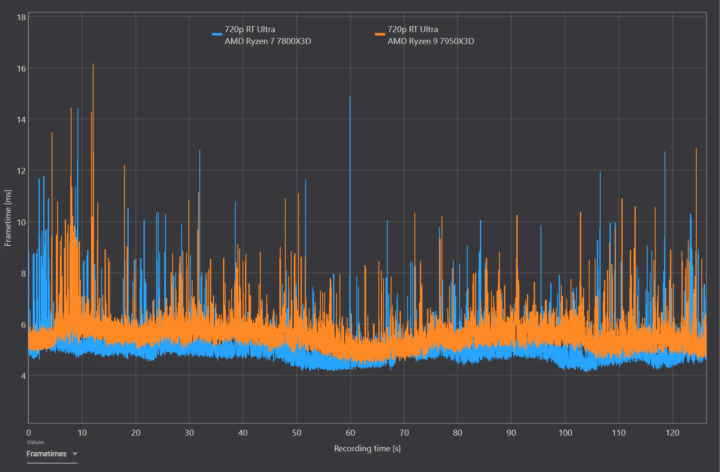
Ghostwire: Tokyo
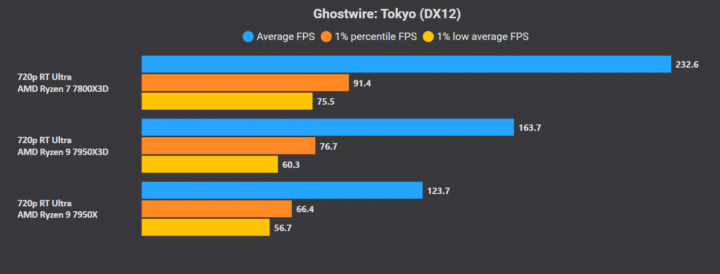
Ghostwire Tokyo runs substantially faster on the 7800X3D, although the frametimes are largely similar on the 7900X3D (barring a few spikes here and there).
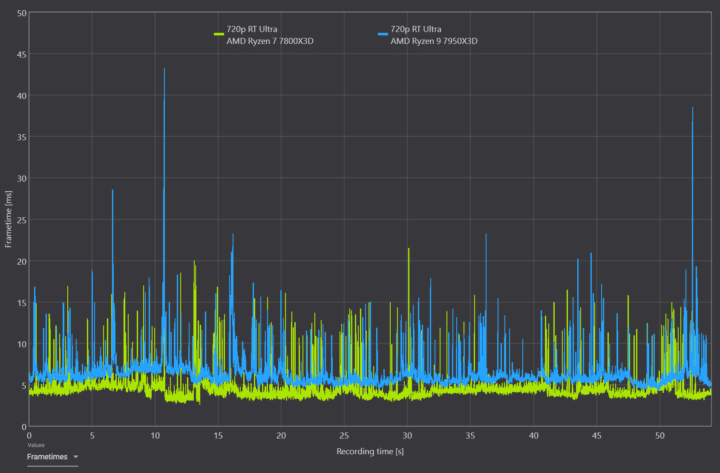
Hitman 3
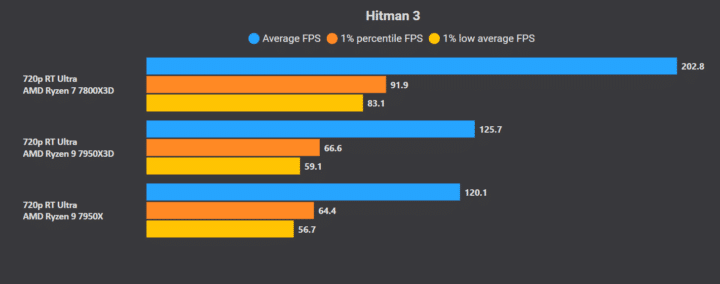
Hitman 3 performs the same. The Ryzen 7 7800X3D is 61% faster than the 7950X3D, with much more consistent frame pacing.
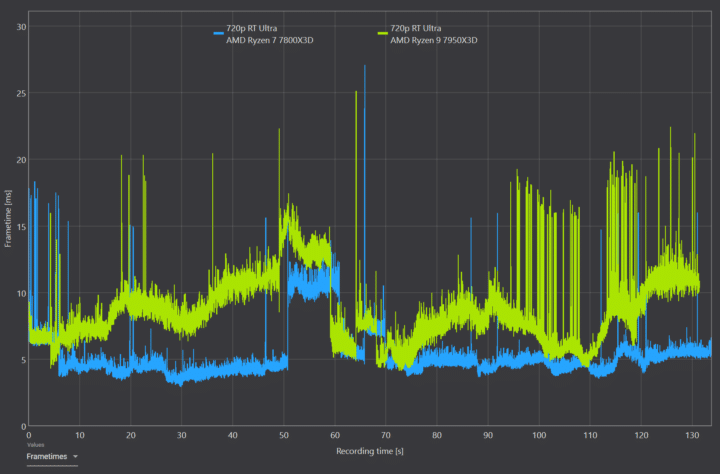
Hogwarts Legacy
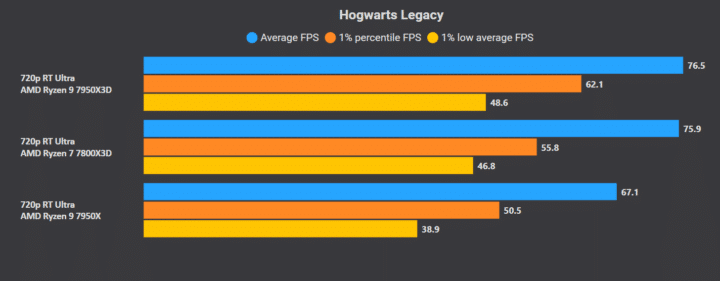
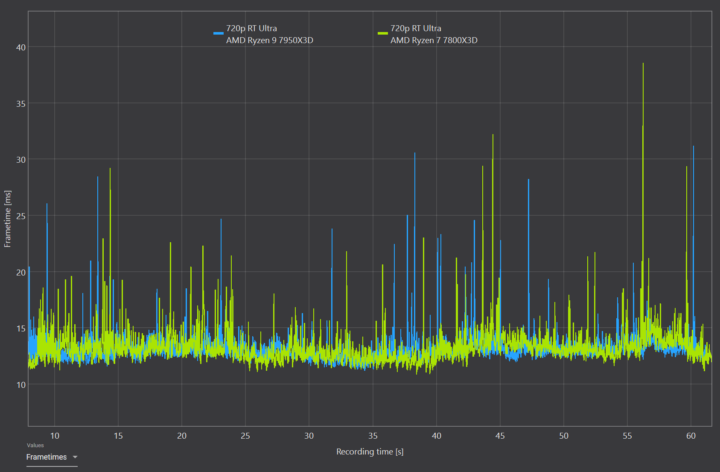
Metro Exodus
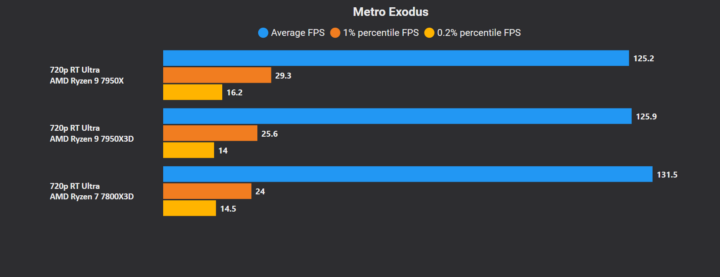
Metro Exodus (Enhanced Edition) doesn’t run well on Ryzen CPUs. There’s a ton of stuttering, with roughly similar averages and lows.
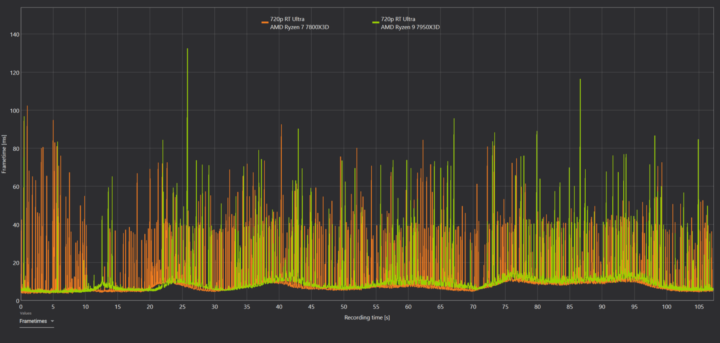
Shadow of the Tomb Raider
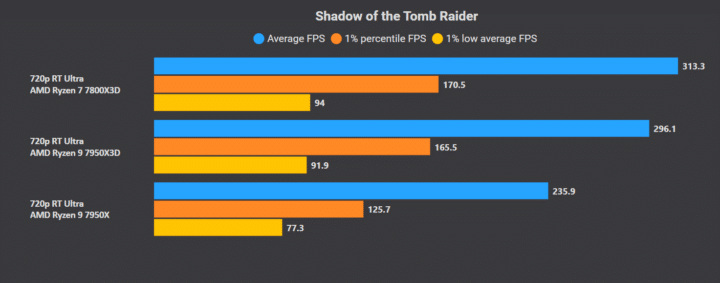
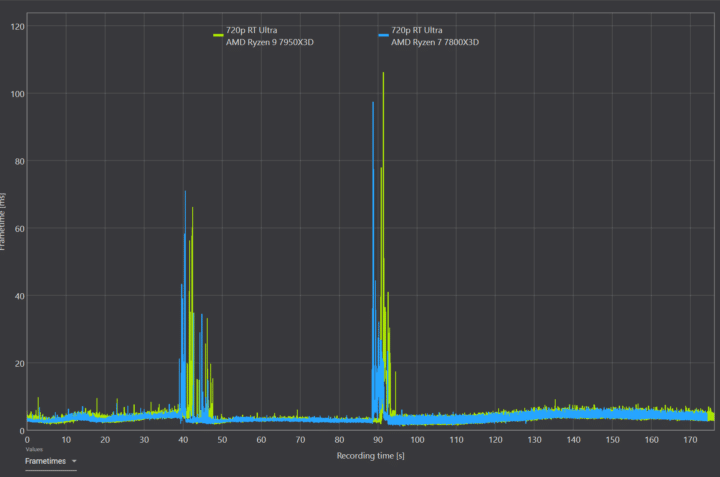
The Callisto Protocol
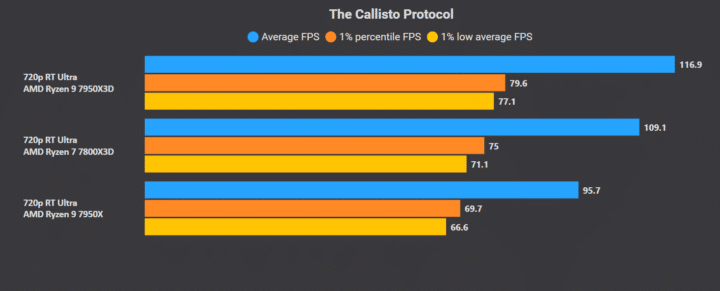
The Callisto Protocol performs better on the Ryzenm 9 7950X3D, holding a slight lead over its octa-core sibling throughout the test.
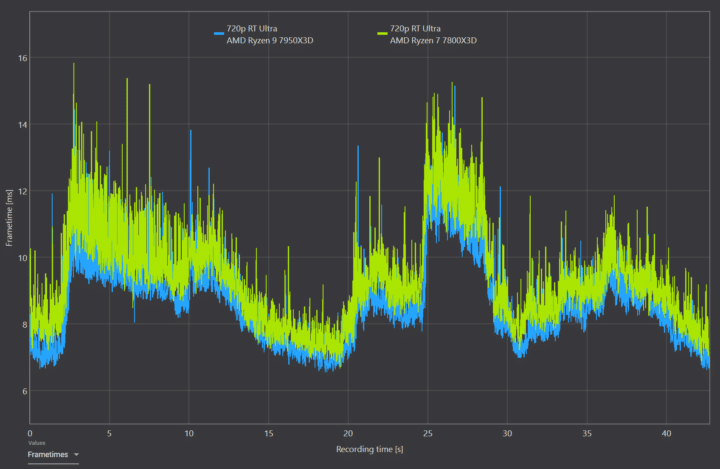
Average Ray Tracing Performance
In ray tracing, the Ryzen 7 7800X3D expands its lead over the 7950X3D to 12%. Titles like Ghostwire and Hitman 3 heavily favor the 7800X3D, making it the better overall gaming CPU.
| Game | Ryzen 7 7800X3D (Avg FPS) | Ryzen 9 7950X3D (Avg FPS) |
|---|---|---|
| A Plague Tale | 123.8 FPS | 130.7 FPS |
| Crysis Remastered | 163.3 FPS | 124.3 FPS |
| Cyberpunk 2077 | 133.6 FPS | 141.7 FPS |
| Dying Light 2 | 222.2 FPS | 218.4 FPS |
| F1 2022 | 199.7 FPS | 178.8 FPS |
| Ghostwire: Tokyo | 232.6 FPS | 163.7 FPS |
| Hitman 3 | 202.8 FPS | 125.7 FPS |
| Hogwarts Legacy | 75.9 FPS | 76.5 FPS |
| Metro Exodus | 131.5 FPS | 125.9 FPS |
| Shadow of the Tomb Raider | 313.3 FPS | 296.1 FPS |
| The Callisto Protocol | 109.1 FPS | 116.9 FPS |
| 11 Game Average | 173.4 FPS | 154.4 FPS |
Thermals, Power Consumption, and Clocks
Here are some interesting numbers from the benchmarks of the two CPUs captured using CapFrameX in Cyberpunk 2077 and Dying Light 2:
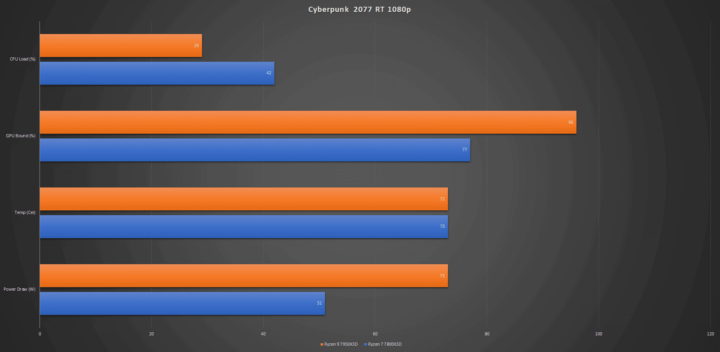
Despite drawing 20% more power, the Ryzen 9 7950X3D has the same average package temperature as the 7800X3D. Furthermore, even though the 7800X3D is faster on average, the game spends more time CPU-bound than the 7950X3D.
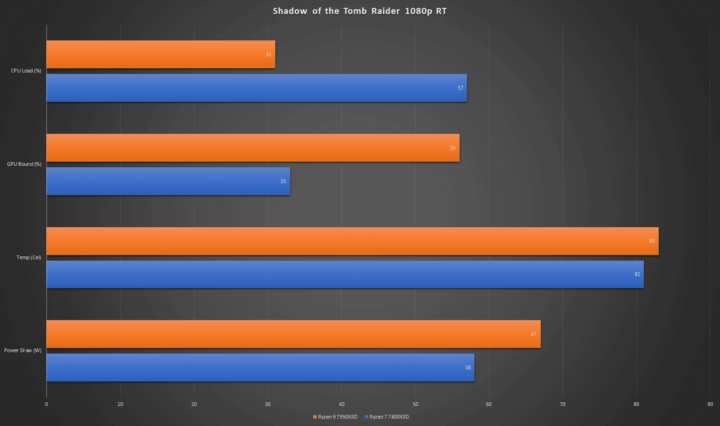
Dying Light 2 exhibits similar characteristics. Even though the 7950X3D draws more power, its thermals are almost identical to the 7800X3D. It also results in fewer CPU-bound scenarios compared to the 7950X3D.
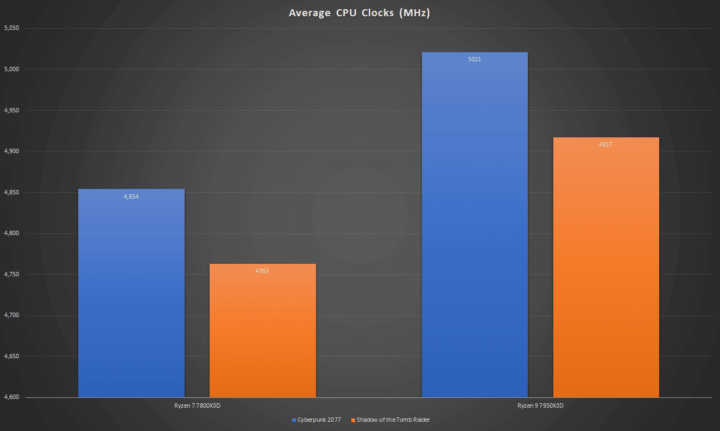
Regarding clock speeds, the Ryzen 9 7950X3D runs 100MHz faster than the Ryzen 7 7800X3D in both games. The boost clock of the V-Cache dies was considered in both cases.
Conclusion
The Ryzen 7 7800X3D is clearly the better gaming CPU. It’s faster, more affordable, and power efficient than the Ryzen 9 7950X3D. The reason why it’s faster is two-fold. The 3D V-Cache boosts gaming performance by localizing the game code to the large L3 cache, improving latency and reducing memory accesses.
With the 7950X3D, the OS sometimes assigns a thread to the cores on the second CCD. Since most of the game code is on the (larger) first CCD, this induces a latency penalty as the core accesses it across the interconnect bus.
The extra cores on the Ryzen 9 7950X3D are nice to have, but games are more sensitive to memory/cache bottlenecks. The 7800X3D, with its large, uniform 96MB L3 cache pool, keeps the needed game code close to the cores in one place. Luckily, if you have a 7950X3D, you can technically run it as a 7800X3D in gaming workloads by disabling the second CCD. Just make sure you disable the one with the lower L3 cache.
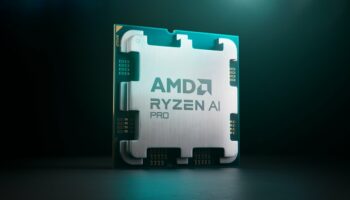 AMD Zen 5 CPUs Allegedly Going to Offer Only 10% IPC Uplift, Claims Lenovo Manager
AMD Zen 5 CPUs Allegedly Going to Offer Only 10% IPC Uplift, Claims Lenovo Manager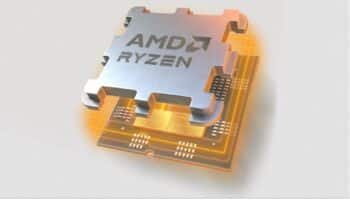 AMD’s Ryzen Desktop CPU Market Share Grows by 21% in Q1 2024; Mobile/Server Flat
AMD’s Ryzen Desktop CPU Market Share Grows by 21% in Q1 2024; Mobile/Server Flat Intel on Crashing CPUs: Baseline Settings Not Suggested for Core i9-13900K/14900K
Intel on Crashing CPUs: Baseline Settings Not Suggested for Core i9-13900K/14900K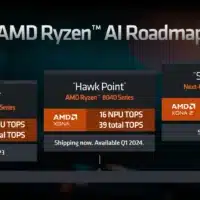 AMD Zen 5 CPUs Get Ryzen AI Branding: 4x More AI Chops than Intel Core Ultra Meteor Lake
AMD Zen 5 CPUs Get Ryzen AI Branding: 4x More AI Chops than Intel Core Ultra Meteor Lake